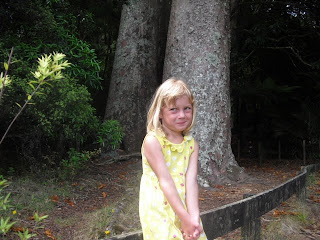
This past weekend we visited the Coromandel Peninsula, which boasts some of the the most scenic swinging in the world. Besides the stunning views from its swing-sets, the Coromandel is also known as a Kiwi vacation Mecca, an area of logging activity, and a highly productive agricultural center. It’s also the setting of Edward Lear’s poem, The Courtship of the Yonghy-Bonghy-Bò.

The Coromandel was once covered with the mighty Kauri tree; they can grow to over 150 feet high, and 16 yards round. The Maori found it ideal for boat building, the Europeans found it ideal for ship masts, and home construction. Its wood is so extraordinary that most of trees have been cut down, and only a few stands remain. Here’s Rachel at the entrance of one of these stands.

Coromandel’s beaches are some of the finest in the world. The first beach we visited was the aptly named Hot Water Beach. Maybe this has happened to you: You're at a beautiful beach, the waves are rolling in, the sun is setting, and you think to yourself, “this would be perfect, if only I had a hot tub.” Well your wish has been granted, it’s called Hot Water Beach. Dig down into the sand at low tide, and you’ll strike hot water that’s rising up from a geothermal fissure. Instant beach hot tub.

Rachel proclaimed that this was her second favorite place in the world. Her favorite place is her friend Peyton’s house. Peyton, of course, has a hamster named Pinkis. Maybe if Hot Water Beach got a hamster named Pinkis and Peyton dropped by to visit it would take top honors.
 Cathedral Cove is on the short list of most New Zealander’s must see places. It is extraordinary.
Cathedral Cove is on the short list of most New Zealander’s must see places. It is extraordinary.
Whether it was worth the hike to get there, which consisted of about 3km of undulating terrain, was of much dissent among our party. Some felt the journey alone was worth the visit. Others felt that the beach, while amazing, was not quite worth the effort.

The swimming and exploring at Cathedral Cove was outstanding.

Whatever you find enjoyable, Coromandel is the type of place where you can bury yourself in fun.
















